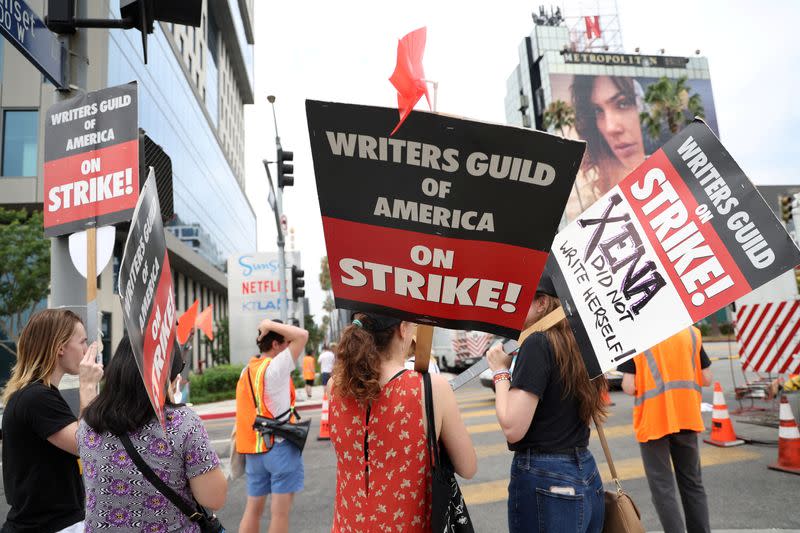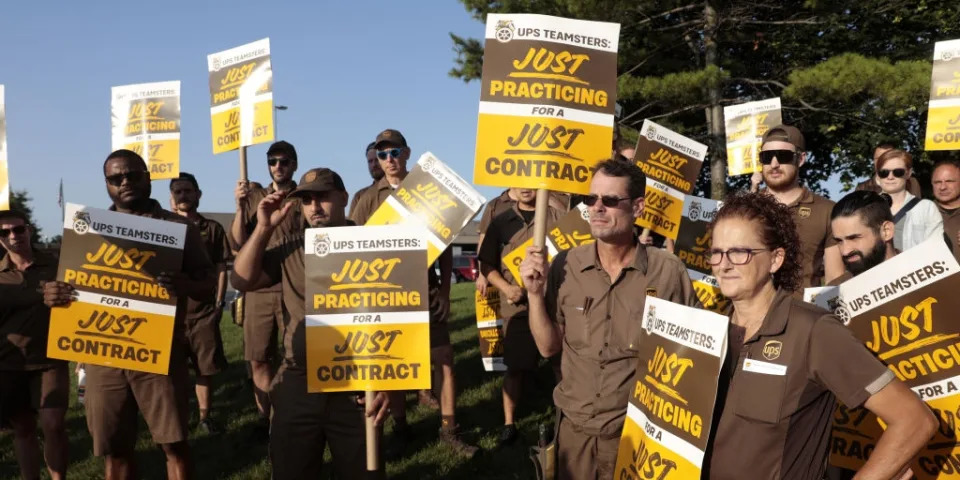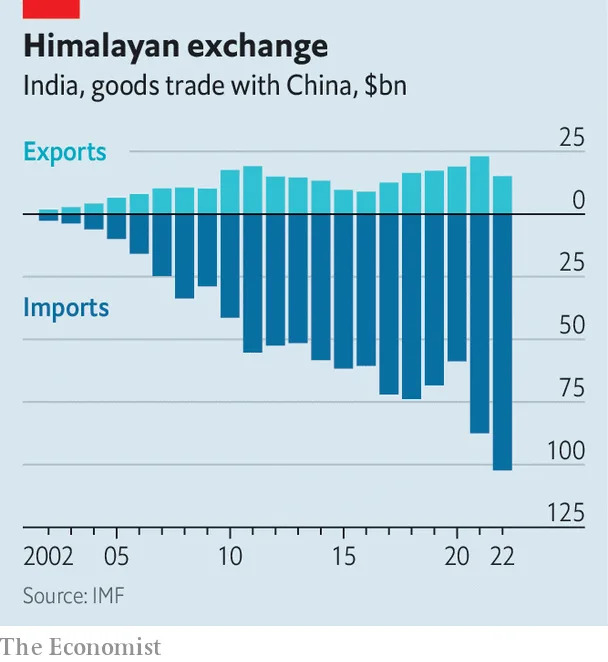
Emil Skandul
Updated Mon, August 14, 2023

The AI revolution is about the crash into the global economy and upend millions of jobs.
A tidal wave is about to crash into the global economy.
The rise of artificial intelligence has captured our imagination for decades, in whimsical movies and sober academic texts. Despite this speculation, the emergence of public, easy-to-use AI tools over the past year has been a jolt, like the future arrived years ahead of schedule. Now this long-expected, all-too-sudden technological revolution is ready to upend the economy.
A March Goldman Sachs report found over 300 million jobs around the world could be disrupted by AI, and the global consulting firm McKinsey estimated at least 12 million Americans would change to another field of work by 2030. A "gale of creative destruction," as economist Joseph Schumpeter once described it, will blow away countless firms and breathe life into new industries. It won't be all bleak: Over the coming decades, nongenerative and generative AI are estimated to add between $17 trillion and $26 trillion to the global economy. And crucially, many of the jobs that will be lost will be replaced by new ones.
The crescendo for this technological wave is surging, and we are at just the beginning of this upheaval that will ripple through the labor market and global economy. It's likely to be a transformation as influential as the industrial revolution and the rise of the internet. The changes could boost living standards, improve productivity, and accelerate economic opportunities, but this rosy future is not guaranteed. Unless governments, CEOs, and workers properly prepare for the upsurge with urgency, the AI revolution could be painful.
We didn't see the internet coming, but AI is within view
The adoption of groundbreaking technology is often hard to predict. Take the internet: In 1995, Newsweek published an article titled, "Why the Web Won't Be Nirvana," making the case that books and airline tickets would never be purchased over the internet. Later that year, Bill Gates was asked by an unconvinced David Letterman, "What about this internet thing?" Even three years later, as adoption grew, the economist Paul Krugman famously declared that the internet's influence would be no greater than that of the fax machine. In hindsight, it's clear that the internet's effects couldn't have been any more miscalculated.
Part of the reason for the initial skepticism was that the influence of the internet was uneven and slow at first but quickly grew as more people learned how it worked. "The rule for exponential curves is that they changed the world slowly at first, and then suddenly," Erik Brynjolfsson, a Stanford University innovation economist, told me.
The arrival of AI presents similar unknowns — but the growth curve is becoming clear much quicker. In 2017, McKinsey estimated that robust large language models such as GPT-4 would be developed by 2027. But they are already here. And seemingly overnight, OpenAI's generative AI was integrated into Microsoft products, and in the span of a few months, corporate giants including Amazon, AT&T, Salesforce, and Cisco have rushed to incorporate enterprise-grade AI tools. McKinsey's latest report predicted that somewhere between 2030 and 2060, half of today's work tasks would be automated. Their best guess as to when this will happen — 2045 — is almost a decade earlier than previously estimated. Things are changing fast.And as adoption picks up, so will the downstream effects of the technology. The World Economic Forum estimated 83 million jobs worldwide would be lost over the next five years because of AI, with 69 million jobs created — that leaves 14 million jobs that will cease to exist during that timeframe. Even the people who do retain their jobs will experience a massive shift in how they do their work: The World Economic Forum says that 44% of workers' core skills are expected to change in the next five years.
Stanford economist Erik Brynjolfsson
Past automation technologies had the most effect on low-skilled workers. But with generative AI, the more educated and highly skilled workers who previously were immune to automation are vulnerable. According to the International Labor Organization, there are between 644 and 997 million knowledge workers globally, between 20% and 30% of total global employment. In the US, the knowledge-worker class is estimated to be nearly 100 million workers, one out of three Americans. A broad spectrum of occupations — marketing and sales, software engineering, research and development, accounting, financial advising, and writing, to name a few — is at risk of being automated away or evolving.
This doesn't mean, however, that there will be a flood of unemployed workers begging for any job. AI will lead to net job creation over the long run, and some roles that seem like they will be affected may actually grow in demand. For instance, ATMs increased the number of bank tellers.
"I do not think we'll see mass unemployment," Brynjolfsson, who anticipates AI spreading faster than other general-purpose technologies, told me. "But I do think we'll see mass disruption, where a lot of wages for some jobs will fall, wages for other jobs will rise, and we'll be shifting around into demand for different kinds of skills. They'll have to be a lot of reallocation of labor and rescaling of labor with winners and losers."
This shift will be so massive that we won't miss many of the jobs that disappear. Before the industrial revolution, the job of a human alarm clock was to wake up workers in the early-morning hours by tapping a broomstick on their window. Thanks to alarm clocks, no one misses this job today. Similarly with AI, there will be jobs that will be conveniently forgotten about.
Permanent mass unemployment can safely be ruled out, but in the short term, the transition will be messy. If one-quarter of tasks across all US occupations were automated by AI, and one-third of workers' workload replaced, it would take only a small segment of the broad white-collar class to simultaneously experience job losses or transitions for it to have a dire impact on the broader economy. This sort of monumental reshuffling requires preparation on the part of governments and businesses. In its most recent employment outlook, the Organization for Economic Co-operation and Development declared that this AI revolution was creating "an urgent need to act now" to help the economy adapt.
Productivity boom
In 1987, the economist Robert Solow famously declared: "You can see the computer age everywhere but in the productivity statistics." Solow's "productivity paradox" spotlighted a key puzzle of the emerging computer age. Even with heavy investments in information technology and computing — which were supposedly making workers more productive — official statistics showed that workers were not producing more per hour.
Robert Gordon, a macroeconomist and self-styled "prophet of pessimism," provocatively suggested that the ho-hum productivity figures proved that new technology today was less radical than in the past and that as a result, the world's advanced economies had entered a point of stagnation. The most impactful technologies — the car, the toilet — have already been invented, he argued, and everything else only incrementally improves productivity. Along the same lines, other economists have suggested that the growth rate of new ideas is slowing.
These arguments may seem like a compelling reason to doubt the productivity gains of AI at first, but there's good reason to think that the latest revolution could produce more rapid gains. The internet's mass adoption required software, network protocols, infrastructure, and devices — it took awhile for every home and office to have computers and internet access.
Today, AI's adoption could happen much faster since the technological infrastructure is already in place. Plus, in contrast to hype cycles around crypto or the metaverse, AI is entering maturity. Its user experience makes it uncomplicated, and it already has practical uses, which is why hundreds of millions of people are already integrating the tech into their day-to-day workflows. This is starting to push the technology into companies.
It's also not AI on its own that's game-changing; layering AI on top of preexisting tech can unlock exponential gains — just as the combination of the internet, GPS technology, and smartphones changed our world. Laser weeders that use AI, GPS, and tractor technology can now comb through crop fields in seconds to zap weeds, eliminating the need for herbicides or large hand-weeding crews. And AI embedded within advanced imaging tools have the potential to diagnose and treat cancer.
If the internet made the world flat, then AI makes the world faster. One recent study conducted by Brynjolfsson and his colleagues quantified the productivity of over 5,000 customer-service agents who used generative-AI technology. The results were encouraging: Call-center operators became 14% more productive, and less experienced workers improved their productivity as much as 30%. A study out of MIT found software developers completed tasks 56% faster with generative-code-completion software, and yet another study found that professional-document writing was 40% faster using generative AI.
The small and large compounding effects of productivity growth across many industries are central to the growth trajectory and the long-run effects of AI. Goldman Sachs estimated that over 10 years, generative AI alone could raise annual US labor-productivity growth by just under 1.5 percentage points, "roughly the same-sized boost that followed the emergence of prior transformative technologies like the electric motor and personal computer." If that proved true, it would lead to an annual increase of 7% in global GDP, while contributing $2.6 trillion to 4.4 trillion to the global economy — about the equivalent of the UK economy.
Brynjolfsson, a "mindful optimist," is confident that these productivity gains will accumulate — and show up in the official stats. He told me that he had a bet with Gordon, the pessimist, that productivity growth over the coming years would outpace the 1.4% annual growth projected by the Congressional Budget Office. "In fact, I think it's going to be closer to double that," he said.
While estimates for productivity reflect how workers within firms will become more efficient at their jobs, it also assumes that laid-off workers will find new jobs. As productivity rises, total economic output will increase and GDP will rise. This will create a virtuous cycle, as companies will need to expand operations to keep up with this increased demand, which means they will need more workers. Plus, labor-productivity growth has been shown to raise real incomes, benefiting workers and households. Simply put: Technological innovation, even as it may lead to worker displacement, will help workers in the long run. A widely cited study by the economist David Autor and colleagues found 60% of workers today had jobs that did not exist 80 years ago, suggesting that 85% growth in employment was a result of technology innovation.
Future proofing — faster and smarter
That's all great news, but the turbulence of the AI revolution can't be ignored. The rapid pace of AI advancement and adoption makes this shift markedly different from past industrial revolutions. It's not as simple as textile workers being replaced by mechanized looms — workforce transformations are happening to varying degrees across occupations. And this pace of change is bound to outrun any changes in education and workforce preparation designed to keep up with the tech.
America's already antiquated workforce education system already fails to address modern workers' needs, let alone what they may need as AI takes hold. Maria Flynn, the CEO of the Washington think tank Jobs for the Future, said the US was encumbered by a "patchwork of programs that don't blend into a nice-looking quilt." In fact, there are 43 federal employment-training programs whose total budget is $20 billion, or less than 0.1% of US GDP. This is an alarmingly trivial amount for an economy of $25 trillion GDP and over 150 million workers.
To ease the pain of the labor-market upheaval, the US needs to invest more in its workforce — and fast. One approach is to adopt Denmark's model of job security and retraining, known as "flexicurity." The system helps avoid structural unemployment by making it easy for employers to let go of workers and by providing a substantial cushion for those laid off. The program provides unemployment benefits for two years at as much as $2,860 a month for people who are laid off, as well as one-on-one job counseling with retraining opportunities. As a result, the Danes are unemployed for much less time compared with workers in similar countries.
The US once had a similar program, the Trade Adjustment Assistance program, which was established in 1974 and administered by the Department of Labor for workers affected by trade and production in other countries. "It was an entitlement program so that any worker who met certain conditions — that their job was displaced due to trade — had an entitlement to receive a package of income support and retraining support," Flynn told me. An expansive and well-funded program geared toward the AI labor-market shift would help ease turbulence for workers by providing relocation grants and wage insurance to temporarily bridge the wage gap when workers find employment in lower-paying jobs.
To retrain people for an AI-based economy, the US could look to Singapore. There, workers above the age of 25 are given $500 in credits to access 24,000 courses in anything from data science to business, and a public-private retraining program makes sure skills training is matched to employers' job classifications. Every year, over 660,000 people make use of the country's national retraining program. For those concerned about productivity lags, these kinds of large-scale upgrades to education and training have the potential to fill in the gaps of a major workforce transition. Singapore's efforts have helped step up the annual labor-productivity growth rate to a respectable 3%.
All these public-sector policies would still need to be complemented by private-sector investment in retraining. In an MIT survey of workers, 50% of respondents reported receiving formal skills training by their employers. Incentivizing retraining through tax credits –– such as those in New York and Georgia –– could spur employers into action and ensure everyone is ready for the AI revolution.
Technology can't be uninvented — disruptive catalysts such as AI require the proactive pursuit of adapting to that change. And making workers resilient to large shocks requires recognizing that this technological wave can temporarily wipe out a large portion of the workforce, or it can be smoothly surfed to calm waters.
Emil Skandul is a writer on technology and urban economics, and a Tony Blair Institute fellow.











